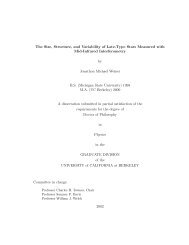Astro 160: The Physics of Stars
Astro 160: The Physics of Stars
Astro 160: The Physics of Stars
You also want an ePaper? Increase the reach of your titles
YUMPU automatically turns print PDFs into web optimized ePapers that Google loves.
L ≈ 0.2(M/M sun ) 4/7 (R/R) 2 sunL sun ≡ LconvI called this luminosity L conv since it is derived from the properties <strong>of</strong> energy transport alone (convectiveinterior + radiative atmosphere with H − opacity). <strong>The</strong> luminosity <strong>of</strong> a star is also given byL f usion = 4πr 2 ρε(T,ρ)drwhere ε is due to the proton-proton chain for low mass stars (this was given in lecture). As discussed inclass, the main sequence is determined by the requirement that the energy escaping the star (in this case byconvection) is equal to the energy generated in the star (in this case by pp fusion), i.e., that L conv = L f usion.a) Use scaling arguments to derive the power-law relations R(M), L(M), T c (M), and L(T e f f ) (the HRdiagram) for fully convective stars, like we did for other examples in lecture. Approximate ε ∝ ρT β withan appropriate choice <strong>of</strong> β (recall that low mass stars will have somewhat lower central temperatures thanthe sun, closer to ≃ ×10 6 K, as you will see in part b).We know thatwe can find what β is byL conv ∝ M 4/7 R 2L f us ∝ R 3 ε(ρ,T) ∝ R 3 ρ 2 T ββ = − 2 ( ) 1/33 + EG4kTgiven that we know what the temperature is and also what E G for p-p reactionE G ≈ 500 keVT ≈ 5 × 10 6 Kwe find thatwe also knowβ = 5.92 ≈ 6.0ρ ∝ M R 3we know that in steady statethus we can findL f usion = L convM 4/7 R 2 ∝ R 3 ( M2R 6 )T 6c ⇒ T 6 ∝ M −5/21 R 5/6we know from the Virial temperature, assuming gas pressure dominatesT ∝ M Rthus we findT c ∝ M 25/77knowing this we can now findR ∝ M 52/77with this and the relationship for the convective luminosity we findL ∝ M 4/7 R 2 ∝ M 148/7726












![Problem #1 [Structure Formation I: Radiation Era]](https://img.yumpu.com/37147371/1/190x245/problem-1-structure-formation-i-radiation-era.jpg?quality=85)



